Pharmaceutical Ointments Base Market
Pharmaceutical Ointments Base Market Size and Share Forecast Outlook 2025 to 2035
The pharmaceutical ointments base market is projected to grow from USD 4.7 billion in 2025 to USD 6.9 billion by 2035, at a CAGR of 3.9%. Hydrocarbon will dominate with a 40.0% market share, while petrochemical will lead the source segment with a 60.0% share.
Pharmaceutical Ointments Base Market Forecast and Outlook 2025 to 2035
The pharmaceutical ointments base market stands at the threshold of a decade-long expansion trajectory that promises to reshape topical drug delivery technology and formulation solutions. The market's journey from USD 4,700.0 million in 2025 to USD 6,891.0 million by 2035 represents substantial growth, the market will rise at a CAGR of 3.9% which demonstrating the accelerating adoption of advanced base formulation technology and pharmaceutical optimization across dermatology applications, cosmetic manufacturing, and veterinary medicine facilities.
The first half of the decade (2025-2030) will witness the market climbing from USD 4,700.0 million to approximately USD 5,565.2 million, adding USD 865.2 million in value, which constitutes 40% of the total forecast growth period. This phase will be characterized by the rapid adoption of hydrocarbon base systems, driven by increasing pharmaceutical manufacturing requirements and the growing need for advanced topical delivery solutions worldwide. Enhanced stability capabilities and standardized processing systems will become standard expectations rather than premium options.
The latter half (2030-2035) will witness continued growth from USD 5,565.2 million to USD 6,891.0 million, representing an addition of USD 1,325.8 million or 60% of the decade's expansion. This period will be defined by mass market penetration of advanced ointment base technologies, integration with comprehensive pharmaceutical platforms, and seamless compatibility with existing drug manufacturing infrastructure. The market trajectory signals fundamental shifts in how pharmaceutical companies approach topical formulation and drug delivery enhancement, with participants positioned to benefit from growing demand across multiple base types and application segments.
Emerging trends in the pharmaceutical ointments base market include the increasing development of multifunctional and hybrid bases that combine emollient, moisturizing, and active drug delivery properties. These innovations are enabling more efficient absorption of active pharmaceutical ingredients (APIs), enhancing therapeutic outcomes while improving patient compliance. Water-soluble and hydrophilic bases are gaining traction for their ease of formulation, reduced greasiness, and compatibility with sensitive skin applications, particularly in dermatology and cosmetic therapies.
The growing emphasis on personalized medicine is also influencing ointment base formulations, with manufacturers exploring customizable bases tailored to specific patient needs, including age-specific, dermatologically sensitive, and condition-specific products. Technological advancements such as microencapsulation and nanoparticle incorporation are being integrated into ointment bases to improve targeted delivery, prolong release, and reduce systemic side effects.
Veterinary medicine applications are expected to drive additional growth, with increased demand for topical treatments in livestock, companion animals, and equine care. Bases that enhance adhesion, moisture retention, and stability under diverse environmental conditions are particularly valued in this segment.
Sustainability considerations are further shaping market developments, as manufacturers prioritize eco-friendly raw materials, biodegradable excipients, and energy-efficient production methods. Strategic collaborations between API developers and base manufacturers are anticipated to optimize formulation efficiency, reduce production costs, and strengthen the overall pharmaceutical supply chain, supporting long-term growth and market resilience through 2035.
Quick Stats for Pharmaceutical Ointments Base Market
- Pharmaceutical Ointments Base Market Value (2025): USD 4,700.0 million
- Pharmaceutical Ointments Base Market Forecast Value (2035): USD 6,891.0 million
- Pharmaceutical Ointments Base Market Forecast CAGR: 3.9%
- Leading Product Type in Pharmaceutical Ointments Base Market: Hydrocarbon Bases
- Key Growth Regions in Pharmaceutical Ointments Base Market: Asia Pacific, North America, and Europe
- Top Players in Pharmaceutical Ointments Base Market: BASF, Croda, Evonik, Dow, Clariant
- Where revenue comes from - now vs next (industry-level view)
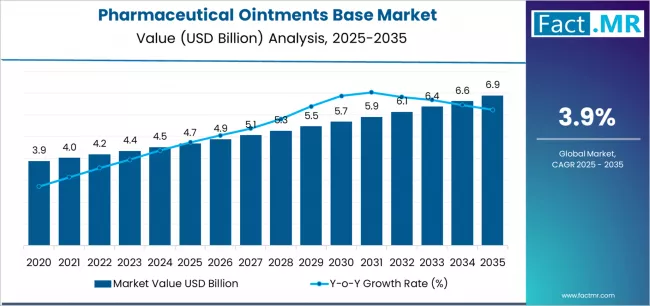
| Period | Primary Revenue Buckets | Share | Notes |
|---|---|---|---|
| Today | Hydrocarbon bases | 40% | Volume-driven, pharmaceutical applications |
| Water-removable bases | 25% | Versatility focus, cosmetic applications | |
| Absorption bases | 20% | Specialty applications, dermatological use | |
| Water-soluble bases | 15% | Specialized formulations, targeted delivery | |
| Future (3-5 yrs) | Advanced hydrocarbon systems | 38-42% | Technology enhancement, stability optimization |
| Enhanced water-removable | 23-27% | Application improvement, versatility positioning | |
| Premium absorption bases | 19-23% | Specialty formulations, advanced delivery | |
| Smart water-soluble systems | 14-18% | Targeted applications, controlled release |
Pharmaceutical Ointments Base Market Key Takeaways
At-a-Glance Metrics
| Metric | Value |
|---|---|
| Market Value (2025) → | USD 4,700.0 million |
| Market Forecast (2035) ↑ | USD 6,891.0 million |
| Growth Rate ★ | 3.9% CAGR |
| Leading Product → | Hydrocarbon Bases |
| Primary Application → | Dermatology Segment |
The market demonstrates strong fundamentals with hydrocarbon bases capturing a dominant 40.0% share through advanced formulation capabilities and stability optimization. Dermatology applications drive primary demand with 55.0% market share, supported by increasing pharmaceutical manufacturing requirements and topical drug development programs.
Geographic expansion remains concentrated in developed markets with established pharmaceutical infrastructure, while emerging economies show accelerating adoption rates driven by healthcare initiatives and rising pharmaceutical standards.
Imperatives for Stakeholders in Pharmaceutical Ointments Base Market
Design for formulation versatility, not just base functionality
- Offer complete formulation packages: pharmaceutical ointment bases + formulation support + documentation + stability testing + technical guidance.
- Preconfigured pharmaceutical workflows: formulation protocols, stability procedures, quality records, and digital tracking on drug development.
Technology readiness for advanced pharmaceuticals
- Real-time stability monitoring analytics, predictive formulation capabilities, and smart pharmaceutical integration (drug delivery connectivity, bioavailability tracking systems).
Performance-by-design approach
- Automated processing systems, real-time consistency mechanisms, statistical pharmaceutical monitoring integration, and paperless formulation documentation.
Value-based ingredient models
- Clear base ingredient price + transparent service tiers (formulation support, technical availability, performance guarantees); subscriptions for digital services and analytics.
Segmental Analysis
The market segments by base chemistry into hydrocarbon, water-removable, absorption, and water-soluble base variants, representing the evolution from basic pharmaceutical bases to specialized drug delivery solutions for comprehensive topical and pharmaceutical optimization.
The source segmentation divides the market into petrochemical (60.0%), natural/organic (20.0%), and synthetic polymers (20.0%) categories, reflecting distinct requirements for sustainability performance, regulatory standards, and formulation capabilities.
The application segmentation covers dermatology (55.0%), cosmetic/personal care (20.0%), veterinary (15.0%), and ophthalmic (10.0%) sectors, addressing different therapeutic requirements from skin treatment to specialized medical applications.
The customer segmentation addresses pharma manufacturers (70.0%), compounding pharmacies (15.0%), and cosmetic formulators (15.0%) categories, reflecting different manufacturing requirements and pharmaceutical specialization needs.
The segmentation structure reveals technology progression from standard pharmaceutical bases toward specialized drug delivery systems with enhanced bioavailability consistency and formulation capabilities, while application diversity spans from dermatological treatment to cosmetic products requiring precise pharmaceutical solutions.
By Base Chemistry, the Hydrocarbon Segment Accounts for Dominant Market Share
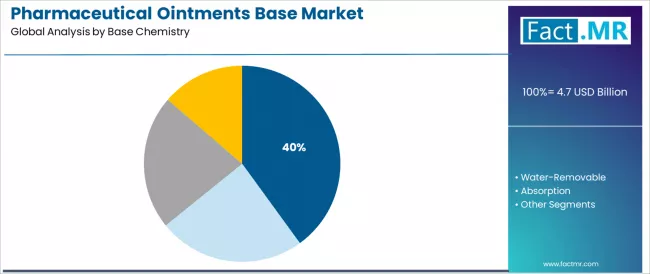
Hydrocarbon pharmaceutical ointments base commands the leading position in the pharmaceutical ointments base market with 40.0% market share through advanced formulation characteristics, including superior stability performance, compatibility optimization, and pharmaceutical integration that enable drug manufacturers to achieve optimal therapeutic delivery across diverse dermatological and topical applications.
The segment benefits from pharmaceutical manufacturer preference for reliable base systems that provide consistent formulation performance, reduced development complexity, and drug optimization without requiring significant process modifications. Advanced stability features enable automated processing systems, drug compatibility, and integration with existing pharmaceutical equipment, where operational performance and regulatory compliance represent critical manufacturing requirements.
Hydrocarbon bases differentiate through proven pharmaceutical reliability, consistent formulation characteristics, and integration with automated drug delivery systems that enhance manufacturing effectiveness while maintaining optimal therapeutic standards for diverse topical and dermatological applications.
Key market characteristics:
- Advanced base designs with optimized stability configuration and bioavailability efficiency capabilities
- Enhanced pharmaceutical effectiveness, enabling 88-93% drug compatibility with reliable performance
- Manufacturing compatibility, including automated pharmaceutical systems, monitoring integration, and process optimization for base performance
Water-Removable Systems Show Strong Versatility Focus
Water-removable bases maintain a 25.0% market position in the pharmaceutical ointments base market due to their proven versatility benefits and broad application characteristics. These systems appeal to manufacturers requiring multi-purpose performance with targeted positioning for cosmetic and dermatological applications. Market growth is driven by versatility segment expansion, emphasizing reliable formulation solutions and application optimization through proven base technologies.
Absorption Bases Serve Specialty Applications
Absorption bases account for 20.0% market share, serving specialized dermatological applications requiring enhanced drug absorption performance and advanced therapeutic characteristics for medical-focused formulation requirements.
Water-Soluble Systems Address Targeted Delivery
Water-soluble bases capture 15.0% market share, focusing on specialized therapeutic applications, controlled release formulations, and operations requiring efficient soluble solutions for targeted drug delivery optimization.
By Source, the Petrochemical Segment Shows Market Leadership
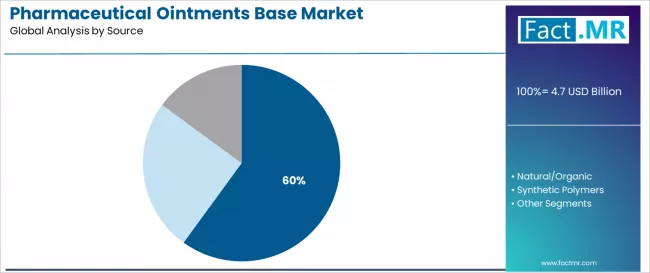
Petrochemical source applications demonstrate market leadership in the pharmaceutical ointments base market with 60.0% share due to widespread adoption of established chemical systems and increasing focus on cost optimization, manufacturing efficiency, and supply reliability that maximize pharmaceutical performance while maintaining economic standards.
Pharmaceutical manufacturers prioritize petrochemical consistency, cost efficiency, and integration with existing production infrastructure that enables coordinated manufacturing operations across multiple pharmaceutical systems. The segment benefits from substantial chemical industry investment and supply programs that emphasize the acquisition of reliable petrochemical systems for cost optimization and manufacturing efficiency applications.
Pharmaceutical programs incorporate petrochemical bases as standard components for drug operations, while manufacturing development growth increases demand for consistent supply capabilities that comply with cost standards and minimize production expenses.
Application dynamics include:
- Strong growth in pharmaceutical manufacturing requiring cost-effective chemical capabilities
- Increasing adoption in supply optimization and manufacturing efficiency applications for drug manufacturers
- Rising integration with automated production systems for operational optimization and cost assurance
Natural/Organic and Synthetic Polymers Applications Maintain Strong Innovation Focus
Natural/organic and synthetic polymers source applications each capture 20.0% market share through comprehensive sustainability requirements in pharmaceutical projects, clean formulation operations, and specialized pharmaceutical manufacturing. These applications demand reliable base systems capable of operating with environmental consciousness while providing effective formulation integration and performance capabilities.
By Application, the Dermatology Segment Leads Market Share
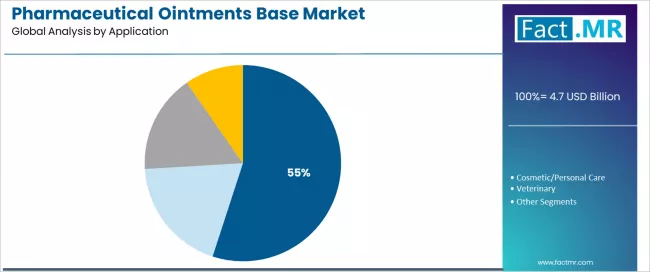
The dermatology segment commands 55.0% market share through widespread adoption in topical medicine applications, skin treatment operations, and dermatological projects. These operations provide advanced therapeutic solutions for complex skin care requirements while maintaining treatment flexibility and efficacy reliability.
Cosmetic/Personal Care Applications Show Consumer Focus
Cosmetic/personal care applications capture 20.0% market share, serving beauty formulations, personal care products, and consumer requiring enhanced aesthetic capabilities for skin care optimization and product appeal.
Veterinary and Ophthalmic Applications Serve Specialized Markets
Veterinary applications account for 15.0% market share, while ophthalmic applications capture 10.0% market share, addressing animal health requirements and eye care applications requiring specialized base capabilities for therapeutic optimization.
By Customer, the Pharma Manufacturers Segment Leads Market Share
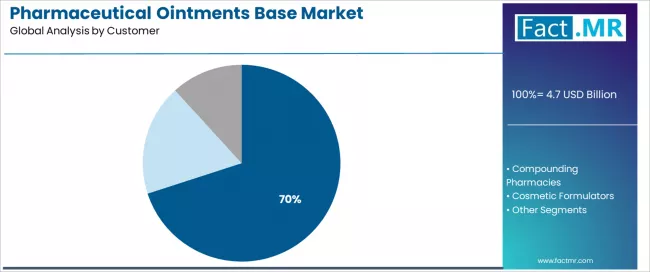
The pharma manufacturers segment commands 70.0% market share through widespread adoption in drug production applications, pharmaceutical operations, and manufacturing projects. These operations provide advanced formulation solutions for complex pharmaceutical requirements while maintaining operational flexibility and regulatory reliability.
Compounding Pharmacies and Cosmetic Formulators Applications Show Specialized Focus
Compounding pharmacies and cosmetic formulators applications each capture 15.0% market share, serving customized formulations, specialty preparations, and operations requiring unique base capabilities for specialized pharmaceutical and cosmetic applications.
What are the Drivers, Restraints, and Key Trends of the Pharmaceutical Ointments Base Market?
| Category | Factor | Impact | Why It Matters |
|---|---|---|---|
| Driver | Dermatological disease prevalence & aging population (skin disorders, chronic conditions) | ★★★★★ | Large-scale healthcare needs require efficient, high-performance base solutions with consistent quality and therapeutic integration across pharmaceutical applications. |
| Driver | Pharmaceutical innovation & drug delivery advancement (topical therapies, targeted delivery) | ★★★★★ | Drives demand for efficient base solutions and formulation-compliant capabilities; suppliers providing bioavailability features gain competitive advantage. |
| Driver | Regulatory compliance & quality standards (FDA approvals, pharmaceutical regulations) | ★★★★☆ | Pharmaceutical manufacturers need advanced, compliant base solutions; demand for regulatory features expanding addressable market segments. |
| Restraint | Raw material costs & supply chain volatility | ★★★★☆ | Small manufacturers face cost pressure; increases price sensitivity and affects adoption in cost-sensitive segments with limited formulation budgets. |
| Restraint | Regulatory approval complexity & formulation validation | ★★★☆☆ | Quality-focused operations face challenges with regulatory complexity and specialized validation requirements, limiting adoption in resource-constrained segments. |
| Trend | Smart pharmaceutical integration & personalized medicine | ★★★★★ | Growing demand for intelligent base solutions; personalization becomes core value proposition in advanced pharmaceutical segments. |
| Trend | Natural ingredients expansion & clean beauty trends | ★★★★☆ | Regional development drives demand for natural base solutions; sustainability capabilities drive competition toward organic positioning. |
Analysis of the Pharmaceutical Ointments Base Market by Key Country
The pharmaceutical ointments base market demonstrates varied regional dynamics with growth leaders including China (5.1% growth rate) and Brazil (4.7% growth rate) driving expansion through pharmaceutical modernization and healthcare development. Strong Performers encompass US (3.6% growth rate), UK (3.6% growth rate), and Germany (3.5% growth rate), benefiting from established pharmaceutical industries and advanced formulation adoption. Mature Markets feature South Korea (3.1% growth rate) and Japan (2.4% growth rate), where pharmaceutical innovation and quality standardization requirements support consistent growth patterns.
Regional synthesis reveals Asian markets leading adoption through healthcare expansion and pharmaceutical modernization development, while Western countries maintain steady expansion supported by innovation advancement and regulatory compliance requirements. Emerging markets show strong growth driven by pharmaceutical applications and healthcare integration trends.
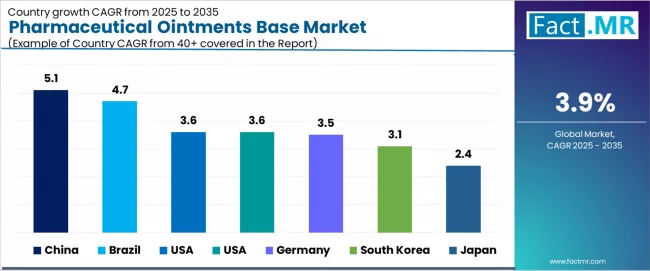
| Region/Country | 2025-2035 Growth | How to win | What to watch out |
|---|---|---|---|
| China | 5.1% | Focus on healthcare-focused pharmaceutical solutions | Regulatory complexity; local competition |
| Brazil | 4.7% | Lead with cost-effective formulation models | Economic dependencies; supply fluctuations |
| US | 3.6% | Value-oriented FDA compliance models | Market maturity; regulatory changes |
| UK | 3.6% | Offer premium pharmaceutical systems | Market maturity; formulation regulations |
| Germany | 3.5% | Provide advanced manufacturing integration | Over-engineering; regulatory compliance |
| South Korea | 3.1% | Push pharmaceutical innovation applications | Technology costs; domestic competition |
| Japan | 2.4% | Premium quality positioning | Market maturity; precision requirements |
China Drives Fastest Market Growth
China establishes fastest market growth through aggressive healthcare modernization programs and comprehensive pharmaceutical development, integrating advanced pharmaceutical ointment base systems as standard components in drug manufacturing, dermatological treatments, and healthcare applications.
The country's 5.1% growth rate reflects government initiatives promoting healthcare advancement and pharmaceutical development capabilities that mandate the use of advanced base systems in drug projects. Growth concentrates in major pharmaceutical centers, including Jiangsu, Shanghai, and Beijing, where pharmaceutical technology development showcases integrated ointment base systems that appeal to manufacturers seeking advanced formulation optimization capabilities and therapeutic management applications.
Chinese manufacturers are developing healthcare-focused pharmaceutical ointment solutions that combine domestic production advantages with advanced formulation features, including stability systems and enhanced bioavailability capabilities. Distribution channels through pharmaceutical suppliers and healthcare service distributors expand market access, while government support for healthcare development supports adoption across diverse pharmaceutical segments.
Strategic Market Indicators:
- Pharmaceutical manufacturing facilities leading adoption with 90% deployment rate in healthcare and drug production sectors
- Government healthcare programs providing substantial demand for domestic pharmaceutical technology development
- Local base manufacturers capturing 58% market share through competitive pricing and localized technical support
- Export market development for healthcare-focused ointment base solutions targeting emerging pharmaceutical markets
Brazil Emerges as High-Growth Market
Brazil's market expansion benefits from diverse pharmaceutical development demand, including healthcare growth in São Paulo and Rio de Janeiro, pharmaceutical manufacturing upgrades, and healthcare programs that increasingly incorporate ointment base systems for therapeutic optimization applications.
The country maintains a 4.7% growth rate, driven by rising healthcare consciousness and increasing recognition of advanced base benefits, including enhanced pharmaceutical performance and improved therapeutic functionality.
Market dynamics focus on cost-effective ointment base solutions that balance advanced pharmaceutical performance with affordability considerations important to Brazilian pharmaceutical operators. Growing healthcare development creates continued demand for base systems in pharmaceutical infrastructure and therapeutic enhancement projects.
Strategic Market Indicators:
- Healthcare-focused pharmaceutical facilities leading adoption with 78% deployment rate in drug manufacturing and therapeutic sectors
- Government healthcare initiatives providing substantial support for domestic pharmaceutical technology development
- Regional manufacturers capturing 45% market share through competitive pricing and localized support
- Growing export opportunities for cost-effective ointment base solutions targeting Latin American pharmaceutical markets
US Shows Advanced Pharmaceutical Integration
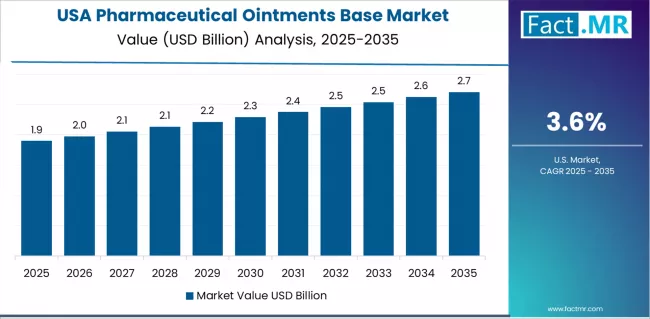
The US establishes advanced pharmaceutical integration through comprehensive healthcare modernization and technology development, integrating pharmaceutical ointment base systems across drug manufacturing facilities and pharmaceutical operations. The country's 3.6% growth rate reflects mature pharmaceutical relationships and established healthcare adoption that supports widespread use of base systems in pharmaceutical and dermatological facilities.
Growth concentrates in major pharmaceutical centers, including New Jersey, California, and North Carolina, where pharmaceutical technology showcases mature ointment base deployment that appeals to operators seeking proven therapeutic capabilities and formulation efficiency applications.
American manufacturers leverage established distribution networks and comprehensive pharmaceutical capabilities, including system integration programs and technical support that create customer relationships and operational advantages. The market benefits from mature FDA standards and pharmaceutical requirements that mandate base system use while supporting technology advancement and therapeutic optimization.
Strategic Market Indicators:
- Pharmaceutical manufacturing facilities leading adoption with 85% deployment rate in FDA-compliant and therapeutic sectors
- Federal healthcare programs providing substantial funding for pharmaceutical formulation technology development
- Domestic manufacturers capturing 52% market share through regulatory expertise and quality positioning
- Strong domestic market focus with premium ointment base solutions for advanced pharmaceutical applications
UK Shows Pharmaceutical Development
The UK establishes pharmaceutical development through comprehensive healthcare modernization and formulation integration, integrating ointment base systems across pharmaceutical and specialty healthcare applications. The country's 3.6% growth rate reflects growing pharmaceutical investment and increasing adoption of base technology that supports expanding use of advanced systems in British pharmaceutical facilities.
Growth concentrates in major regions, including Southeast, Northwest, and East of England, where pharmaceutical technology development showcases integrated ointment base systems that appeal to British operators seeking advanced formulation solutions with therapeutic compatibility.
Market players in the UK focus on maintaining quality standards while adopting pharmaceutical efficiency, creating demand for systems that balance performance with operational advantages. The market benefits from strong pharmaceutical infrastructure and growing healthcare consciousness that support base technology adoption while maintaining quality standards important to British pharmaceutical applications.
Strategic Market Indicators:
- Healthcare-focused pharmaceutical facilities leading adoption with 82% deployment rate in formulation and therapeutic sectors
- Government pharmaceutical initiatives providing substantial support for healthcare innovation and base development
- Local manufacturers capturing 48% market share through healthcare-focused positioning and quality standards
- Growing export opportunities in pharmaceutical ointment base solutions targeting Commonwealth and European markets
Germany Shows Technology Leadership
Germany's advanced pharmaceutical technology market demonstrates sophisticated ointment base system deployment with documented operational effectiveness in pharmaceutical applications and healthcare projects through integration with existing manufacturing systems and pharmaceutical infrastructure.
The country leverages engineering expertise in pharmaceutical technology and healthcare systems integration to maintain a 3.5% growth rate. Pharmaceutical centers, including North Rhine-Westphalia, Bavaria, and Hesse, showcase premium installations where ointment base systems integrate with comprehensive pharmaceutical platforms and quality management systems to optimize drug operations and therapeutic effectiveness.
German manufacturers prioritize system precision and EU compliance in pharmaceutical development, creating demand for premium systems with advanced features, including therapeutic monitoring integration and automated formulation systems. The market benefits from established pharmaceutical technology infrastructure and willingness to invest in advanced base technologies that provide long-term therapeutic benefits and compliance with international pharmaceutical standards.
Strategic Market Indicators:
- Premium pharmaceutical facilities leading adoption with 88% deployment rate in formulation and healthcare sectors
- EU pharmaceutical compliance programs driving substantial investment in advanced base technology development
- Local technology manufacturers capturing 55% market share through engineering excellence and regulatory expertise
- Export leadership in high-quality ointment base solutions targeting developed European pharmaceutical markets
South Korea Shows Pharmaceutical Innovation Development
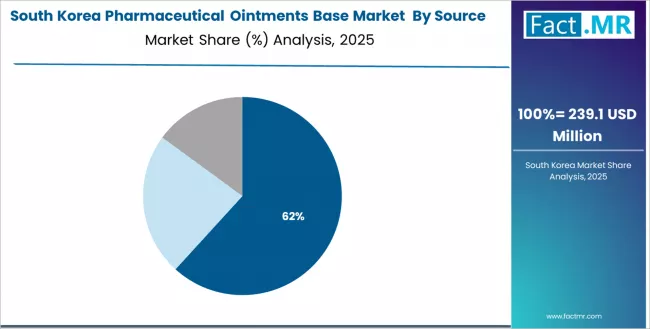
South Korea establishes pharmaceutical innovation development through comprehensive healthcare modernization and technology integration, integrating ointment base systems across pharmaceutical processing and specialty healthcare applications.
The country's 3.1% growth rate reflects growing innovation investment and increasing adoption of base technology that supports expanding use of advanced systems in Korean pharmaceutical facilities.
Growth concentrates in major areas, including Seoul metropolitan area, Incheon, and Sejong, where pharmaceutical technology development showcases integrated ointment base systems that appeal to Korean operators seeking advanced healthcare solutions with innovation compatibility.
South Korean manufacturers focus on maintaining quality standards while adopting pharmaceutical innovation, creating demand for systems that balance performance with technological advantages. The market benefits from strong healthcare infrastructure and growing export opportunities that support base technology adoption while maintaining quality standards important to Korean pharmaceutical applications.
Strategic Market Indicators:
- Technology-advanced pharmaceutical facilities leading adoption with 75% deployment rate in innovation and K-pharma sectors
- Government innovation programs providing substantial investment in healthcare-focused technology development
- Local manufacturers capturing 42% market share through technological advancement and export excellence
- Strong export growth in premium ointment base solutions targeting Asian and global pharmaceutical markets
Japan Demonstrates Premium Pharmaceutical Focus
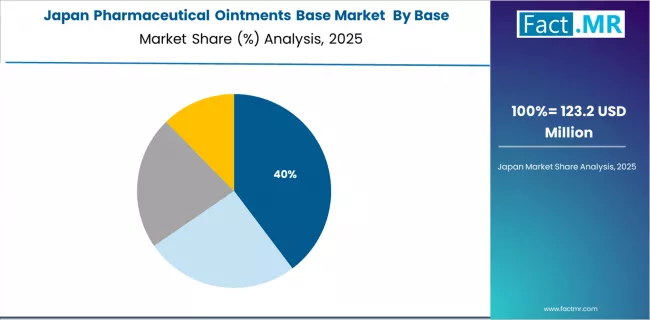
Japan's advanced pharmaceutical technology market demonstrates sophisticated ointment base system deployment with documented operational effectiveness in premium healthcare applications and specialized pharmaceutical projects through integration with existing quality systems and pharmaceutical infrastructure.
The country maintains a 2.4% growth rate, leveraging traditional quality expertise and precision systems integration in pharmaceutical technology. Pharmaceutical centers, including Tokyo, Osaka, and Nagoya, showcase premium installations where ointment base systems integrate with traditional quality platforms and modern pharmaceutical management systems to optimize healthcare operations and maintain therapeutic quality profiles.
Japanese manufacturers prioritize pharmaceutical precision and quality consistency in base development, creating demand for premium systems with advanced features, including quality monitoring and automated pharmaceutical systems. The market benefits from established quality infrastructure and commitment to pharmaceutical standards that provide long-term operational benefits and compliance with traditional quality healthcare methods.
Strategic Market Indicators:
- Premium quality pharmaceutical facilities leading adoption with 72% deployment rate in high-end healthcare and traditional sectors
- Traditional quality programs combined with modern innovation driving substantial investment in precision base technology
- Domestic manufacturers capturing 38% market share through quality excellence and precision manufacturing
- Export leadership in ultra-premium ointment base solutions targeting global premium and luxury pharmaceutical markets
Europe Market Split by Country
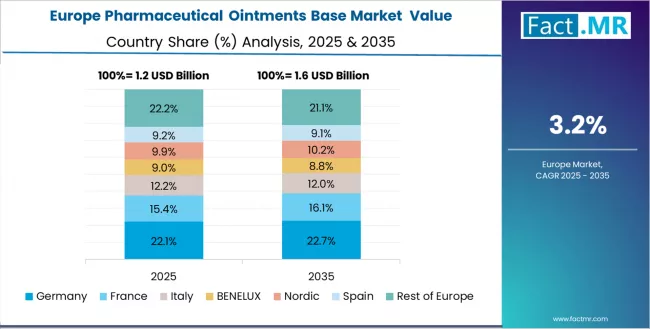
The pharmaceutical ointments base market in Europe is projected to grow from USD 1,410.0 million in 2025 to USD 1,965.0 million by 2035, registering a CAGR of 3.4% over the forecast period. Germany is expected to maintain its leadership position with a 28.4% market share in 2025, growing to 29.1% by 2035, supported by its advanced pharmaceutical infrastructure and major research centers including North Rhine-Westphalia and Bavaria.
The UK follows with a 21.3% share in 2025, projected to reach 21.6% by 2035, driven by comprehensive pharmaceutical programs and formulation innovation development. France holds a 18.7% share in 2025, expected to maintain 18.4% by 2035 despite market adjustments. Italy commands a 15.9% share, while Spain accounts for 12.1% in 2025.
The rest of Europe region is anticipated to gain momentum, maintaining its collective share at approximately 13.6% by 2035, attributed to increasing pharmaceutical ointment base adoption in Nordic countries and emerging pharmaceutical facilities implementing healthcare-focused programs.
Competitive Landscape of the Pharmaceutical Ointments Base Market
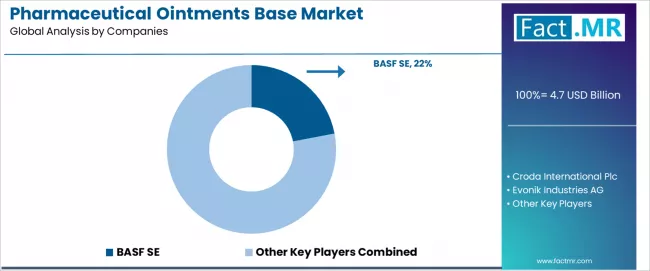
- Structure: ~18-22 credible players; top 5 hold ~32-37% by revenue.
- Leadership is maintained through: formulation expertise, pharmaceutical innovation, and regulatory reliability (therapeutic consistency + stability performance + healthcare integration).
- What's commoditizing: standard hydrocarbon bases and basic formulation configurations.
- Margin Opportunities: specialized therapeutic solutions, personalized formulation integration, and comprehensive pharmaceutical packages (regulatory services, formulation management, stability monitoring).
| Stakeholder | What they actually control | Typical strengths | Typical blind spots |
|---|---|---|---|
| Global platforms | Pharmaceutical reach, deep formulation catalogs, manufacturing facilities | Broad availability, proven reliability, multi-region projects | Technology refresh cycles; application dependency management |
| Technology innovators | R&D capabilities; advanced base systems; therapeutic interfaces | Latest technology first; attractive ROI on large projects | Service density outside core regions; customization complexity |
| Regional specialists | Local sourcing, fast delivery, nearby pharmaceutical support | "Close to site" support; pragmatic pricing; local healthcare codes | Technology gaps; talent retention in pharmaceutical engineering |
| Quality-focused ecosystems | Pharmaceutical consistency, technical support, regulatory sourcing | Lowest performance variation; comprehensive support | Implementation costs if overpromised; technology obsolescence |
| Application specialists | Specialized configurations, custom solutions, pharmaceutical development | Win specialized projects; flexible engineering | Scalability limitations; narrow market focus |
Key Players in the Pharmaceutical Ointments Base Market
- BASF SE
- Croda International Plc
- Evonik Industries AG
- The Dow Chemical Company
- Clariant AG
- Lubrizol Corporation
- IOI Oleochemical Industries Berhad
- AAK AB
- Ashland Global Holdings, Inc.
- Avantor, Inc.
Scope of the Report
| Items | Values |
|---|---|
| Quantitative Units (2025) | USD 4,700.0 million |
| Base Chemistry | Hydrocarbon, Water-Removable, Absorption, Water-Soluble |
| Source | Petrochemical, Natural/Organic, Synthetic Polymers |
| Application | Dermatology, Cosmetic/Personal Care, Veterinary, Ophthalmic |
| Customer | Pharma Manufacturers, Compounding Pharmacies, Cosmetic Formulators |
| Regions Covered | Asia Pacific, North America, Europe, South America, Middle East & Africa |
| Countries Covered | China, USA, Germany, United Kingdom, Japan, South Korea, Brazil, and 25+ additional countries |
| Key Companies Profiled | BASF, Croda, Evonik, Dow, Clariant, Lubrizol, IOI Oleo, AAK, Ashland |
| Additional Attributes | Dollar sales by base chemistry and application categories, regional adoption trends across Asia Pacific, North America, and Europe, competitive landscape with chemical manufacturers and pharmaceutical suppliers, manufacturer preferences for base consistency and formulation reliability, integration with pharmaceutical platforms and quality management systems, innovations in ointment base technology and therapeutic enhancement, and development of advanced formulation solutions with enhanced performance and pharmaceutical optimization capabilities. |
Pharmaceutical Ointments Base Market by Segments
-
Base Chemistry :
- Hydrocarbon
- Water-Removable
- Absorption
- Water-Soluble
-
Source :
- Petrochemical
- Natural/Organic
- Synthetic Polymers
-
Application :
- Dermatology
- Cosmetic/Personal Care
- Veterinary
- Ophthalmic
-
Customer :
- Pharma Manufacturers
- Compounding Pharmacies
- Cosmetic Formulators
-
Region :
- Asia Pacific
- China
- Japan
- South Korea
- India
- ASEAN
- Australia & New Zealand
- Rest of Asia Pacific
- North America
- USA
- Canada
- Mexico
- Europe
- Germany
- France
- United Kingdom
- Italy
- Spain
- Rest of Europe
- South America
- Brazil
- Rest of South America
- Middle East & Africa
- GCC Countries
- South Africa
- Rest of Middle East & Africa
- Asia Pacific
Table of Content
- Executive Summary
- Global Market Outlook
- Demand to side Trends
- Supply to side Trends
- Technology Roadmap Analysis
- Analysis and Recommendations
- Market Overview
- Market Coverage / Taxonomy
- Market Definition / Scope / Limitations
- Market Background
- Market Dynamics
- Drivers
- Restraints
- Opportunity
- Trends
- Scenario Forecast
- Demand in Optimistic Scenario
- Demand in Likely Scenario
- Demand in Conservative Scenario
- Opportunity Map Analysis
- Product Life Cycle Analysis
- Supply Chain Analysis
- Investment Feasibility Matrix
- Value Chain Analysis
- PESTLE and Porter’s Analysis
- Regulatory Landscape
- Regional Parent Market Outlook
- Production and Consumption Statistics
- Import and Export Statistics
- Market Dynamics
- Global Market Analysis 2020 to 2024 and Forecast, 2025 to 2035
- Historical Market Size Value (USD Million) Analysis, 2020 to 2024
- Current and Future Market Size Value (USD Million) Projections, 2025 to 2035
- Y to o to Y Growth Trend Analysis
- Absolute $ Opportunity Analysis
- Global Market Pricing Analysis 2020 to 2024 and Forecast 2025 to 2035
- Global Market Analysis 2020 to 2024 and Forecast 2025 to 2035, By Drive/Type
- Introduction / Key Findings
- Historical Market Size Value (USD Million) Analysis By Drive/Type , 2020 to 2024
- Current and Future Market Size Value (USD Million) Analysis and Forecast By Drive/Type , 2025 to 2035
- Hydraulic Orbital Press
- Servo-Electric
- Mechanical/Eccentric
- Hybrid/Other
- Y to o to Y Growth Trend Analysis By Drive/Type , 2020 to 2024
- Absolute $ Opportunity Analysis By Drive/Type , 2025 to 2035
- Global Market Analysis 2020 to 2024 and Forecast 2025 to 2035, By Workpiece
- Introduction / Key Findings
- Historical Market Size Value (USD Million) Analysis By Workpiece, 2020 to 2024
- Current and Future Market Size Value (USD Million) Analysis and Forecast By Workpiece, 2025 to 2035
- Bearings/Races
- Gears/Transmission
- Aero Rings/Flanges
- Pipes/Fittings & Other
- Y to o to Y Growth Trend Analysis By Workpiece, 2020 to 2024
- Absolute $ Opportunity Analysis By Workpiece, 2025 to 2035
- Global Market Analysis 2020 to 2024 and Forecast 2025 to 2035, By Force Capacity
- Introduction / Key Findings
- Historical Market Size Value (USD Million) Analysis By Force Capacity, 2020 to 2024
- Current and Future Market Size Value (USD Million) Analysis and Forecast By Force Capacity, 2025 to 2035
- ≤2 MN
- 2-5 MN
- 5-10 MN
- 10 MN
- Y to o to Y Growth Trend Analysis By Force Capacity, 2020 to 2024
- Absolute $ Opportunity Analysis By Force Capacity, 2025 to 2035
- Global Market Analysis 2020 to 2024 and Forecast 2025 to 2035, By End Industry
- Introduction / Key Findings
- Historical Market Size Value (USD Million) Analysis By End Industry, 2020 to 2024
- Current and Future Market Size Value (USD Million) Analysis and Forecast By End Industry, 2025 to 2035
- Automotive/EV
- Industrial Machinery
- Aerospace/Defense
- Oil & Gas/Power
- Y to o to Y Growth Trend Analysis By End Industry, 2020 to 2024
- Absolute $ Opportunity Analysis By End Industry, 2025 to 2035
- Global Market Analysis 2020 to 2024 and Forecast 2025 to 2035, By Region
- Introduction
- Historical Market Size Value (USD Million) Analysis By Region, 2020 to 2024
- Current Market Size Value (USD Million) Analysis and Forecast By Region, 2025 to 2035
- North America
- Latin America
- Western Europe
- Eastern Europe
- East Asia
- South Asia and Pacific
- Middle East & Africa
- Market Attractiveness Analysis By Region
- North America Market Analysis 2020 to 2024 and Forecast 2025 to 2035, By Country
- Historical Market Size Value (USD Million) Trend Analysis By Market Taxonomy, 2020 to 2024
- Market Size Value (USD Million) Forecast By Market Taxonomy, 2025 to 2035
- By Country
- USA
- Canada
- Mexico
- By Drive/Type
- By Workpiece
- By Force Capacity
- By End Industry
- By Country
- Market Attractiveness Analysis
- By Country
- By Drive/Type
- By Workpiece
- By Force Capacity
- By End Industry
- Key Takeaways
- Latin America Market Analysis 2020 to 2024 and Forecast 2025 to 2035, By Country
- Historical Market Size Value (USD Million) Trend Analysis By Market Taxonomy, 2020 to 2024
- Market Size Value (USD Million) Forecast By Market Taxonomy, 2025 to 2035
- By Country
- Brazil
- Chile
- Rest of Latin America
- By Drive/Type
- By Workpiece
- By Force Capacity
- By End Industry
- By Country
- Market Attractiveness Analysis
- By Country
- By Drive/Type
- By Workpiece
- By Force Capacity
- By End Industry
- Key Takeaways
- Western Europe Market Analysis 2020 to 2024 and Forecast 2025 to 2035, By Country
- Historical Market Size Value (USD Million) Trend Analysis By Market Taxonomy, 2020 to 2024
- Market Size Value (USD Million) Forecast By Market Taxonomy, 2025 to 2035
- By Country
- Germany
- UK
- Italy
- Spain
- France
- Nordic
- BENELUX
- Rest of Western Europe
- By Drive/Type
- By Workpiece
- By Force Capacity
- By End Industry
- By Country
- Market Attractiveness Analysis
- By Country
- By Drive/Type
- By Workpiece
- By Force Capacity
- By End Industry
- Key Takeaways
- Eastern Europe Market Analysis 2020 to 2024 and Forecast 2025 to 2035, By Country
- Historical Market Size Value (USD Million) Trend Analysis By Market Taxonomy, 2020 to 2024
- Market Size Value (USD Million) Forecast By Market Taxonomy, 2025 to 2035
- By Country
- Russia
- Poland
- Hungary
- Balkan & Baltic
- Rest of Eastern Europe
- By Drive/Type
- By Workpiece
- By Force Capacity
- By End Industry
- By Country
- Market Attractiveness Analysis
- By Country
- By Drive/Type
- By Workpiece
- By Force Capacity
- By End Industry
- Key Takeaways
- East Asia Market Analysis 2020 to 2024 and Forecast 2025 to 2035, By Country
- Historical Market Size Value (USD Million) Trend Analysis By Market Taxonomy, 2020 to 2024
- Market Size Value (USD Million) Forecast By Market Taxonomy, 2025 to 2035
- By Country
- China
- Japan
- South Korea
- By Drive/Type
- By Workpiece
- By Force Capacity
- By End Industry
- By Country
- Market Attractiveness Analysis
- By Country
- By Drive/Type
- By Workpiece
- By Force Capacity
- By End Industry
- Key Takeaways
- South Asia and Pacific Market Analysis 2020 to 2024 and Forecast 2025 to 2035, By Country
- Historical Market Size Value (USD Million) Trend Analysis By Market Taxonomy, 2020 to 2024
- Market Size Value (USD Million) Forecast By Market Taxonomy, 2025 to 2035
- By Country
- India
- ASEAN
- Australia & New Zealand
- Rest of South Asia and Pacific
- By Drive/Type
- By Workpiece
- By Force Capacity
- By End Industry
- By Country
- Market Attractiveness Analysis
- By Country
- By Drive/Type
- By Workpiece
- By Force Capacity
- By End Industry
- Key Takeaways
- Middle East & Africa Market Analysis 2020 to 2024 and Forecast 2025 to 2035, By Country
- Historical Market Size Value (USD Million) Trend Analysis By Market Taxonomy, 2020 to 2024
- Market Size Value (USD Million) Forecast By Market Taxonomy, 2025 to 2035
- By Country
- Kingdom of Saudi Arabia
- Other GCC Countries
- Turkiye
- South Africa
- Other African Union
- Rest of Middle East & Africa
- By Drive/Type
- By Workpiece
- By Force Capacity
- By End Industry
- By Country
- Market Attractiveness Analysis
- By Country
- By Drive/Type
- By Workpiece
- By Force Capacity
- By End Industry
- Key Takeaways
- Key Countries Market Analysis
- USA
- Pricing Analysis
- Market Share Analysis, 2024
- By Drive/Type
- By Workpiece
- By Force Capacity
- By End Industry
- Canada
- Pricing Analysis
- Market Share Analysis, 2024
- By Drive/Type
- By Workpiece
- By Force Capacity
- By End Industry
- Mexico
- Pricing Analysis
- Market Share Analysis, 2024
- By Drive/Type
- By Workpiece
- By Force Capacity
- By End Industry
- Brazil
- Pricing Analysis
- Market Share Analysis, 2024
- By Drive/Type
- By Workpiece
- By Force Capacity
- By End Industry
- Chile
- Pricing Analysis
- Market Share Analysis, 2024
- By Drive/Type
- By Workpiece
- By Force Capacity
- By End Industry
- Germany
- Pricing Analysis
- Market Share Analysis, 2024
- By Drive/Type
- By Workpiece
- By Force Capacity
- By End Industry
- UK
- Pricing Analysis
- Market Share Analysis, 2024
- By Drive/Type
- By Workpiece
- By Force Capacity
- By End Industry
- Italy
- Pricing Analysis
- Market Share Analysis, 2024
- By Drive/Type
- By Workpiece
- By Force Capacity
- By End Industry
- Spain
- Pricing Analysis
- Market Share Analysis, 2024
- By Drive/Type
- By Workpiece
- By Force Capacity
- By End Industry
- France
- Pricing Analysis
- Market Share Analysis, 2024
- By Drive/Type
- By Workpiece
- By Force Capacity
- By End Industry
- India
- Pricing Analysis
- Market Share Analysis, 2024
- By Drive/Type
- By Workpiece
- By Force Capacity
- By End Industry
- ASEAN
- Pricing Analysis
- Market Share Analysis, 2024
- By Drive/Type
- By Workpiece
- By Force Capacity
- By End Industry
- Australia & New Zealand
- Pricing Analysis
- Market Share Analysis, 2024
- By Drive/Type
- By Workpiece
- By Force Capacity
- By End Industry
- China
- Pricing Analysis
- Market Share Analysis, 2024
- By Drive/Type
- By Workpiece
- By Force Capacity
- By End Industry
- Japan
- Pricing Analysis
- Market Share Analysis, 2024
- By Drive/Type
- By Workpiece
- By Force Capacity
- By End Industry
- South Korea
- Pricing Analysis
- Market Share Analysis, 2024
- By Drive/Type
- By Workpiece
- By Force Capacity
- By End Industry
- Russia
- Pricing Analysis
- Market Share Analysis, 2024
- By Drive/Type
- By Workpiece
- By Force Capacity
- By End Industry
- Poland
- Pricing Analysis
- Market Share Analysis, 2024
- By Drive/Type
- By Workpiece
- By Force Capacity
- By End Industry
- Hungary
- Pricing Analysis
- Market Share Analysis, 2024
- By Drive/Type
- By Workpiece
- By Force Capacity
- By End Industry
- Kingdom of Saudi Arabia
- Pricing Analysis
- Market Share Analysis, 2024
- By Drive/Type
- By Workpiece
- By Force Capacity
- By End Industry
- Turkiye
- Pricing Analysis
- Market Share Analysis, 2024
- By Drive/Type
- By Workpiece
- By Force Capacity
- By End Industry
- South Africa
- Pricing Analysis
- Market Share Analysis, 2024
- By Drive/Type
- By Workpiece
- By Force Capacity
- By End Industry
- USA
- Market Structure Analysis
- Competition Dashboard
- Competition Benchmarking
- Market Share Analysis of Top Players
- By Regional
- By Drive/Type
- By Workpiece
- By Force Capacity
- By End Industry
- Competition Analysis
- Competition Deep Dive
- Masa GmbH (Mecolpress Group)
- Overview
- Product Portfolio
- Profitability by Market Segments (Product/Age /Sales Channel/Region)
- Sales Footprint
- Strategy Overview
- Marketing Strategy
- Product Strategy
- Channel Strategy
- Schuler Group GmbH
- SMS group GmbH
- AIDA Engineering, Ltd.
- Lasco Umformtechnik GmbH
- Nidec Press & Automation Co., Ltd.
- Ajax-CECO International, Inc.
- Anyang Forging Press Co., Ltd.
- Danieli & C. Officine Meccaniche S.p.A. (Danieli Breda)
- Siempelkamp Maschinen- und Anlagenbau GmbH & Co. KG
- Masa GmbH (Mecolpress Group)
- Competition Deep Dive
- Assumptions & Acronyms Used
- Research Methodology
List Of Table
- Table 1: Global Market Value (USD Million) Forecast by Region, 2020 to 2035
- Table 2: Global Market Value (USD Million) Forecast by Drive/Type , 2020 to 2035
- Table 3: Global Market Value (USD Million) Forecast by Workpiece, 2020 to 2035
- Table 4: Global Market Value (USD Million) Forecast by Force Capacity, 2020 to 2035
- Table 5: Global Market Value (USD Million) Forecast by End Industry, 2020 to 2035
- Table 6: North America Market Value (USD Million) Forecast by Country, 2020 to 2035
- Table 7: North America Market Value (USD Million) Forecast by Drive/Type , 2020 to 2035
- Table 8: North America Market Value (USD Million) Forecast by Workpiece, 2020 to 2035
- Table 9: North America Market Value (USD Million) Forecast by Force Capacity, 2020 to 2035
- Table 10: North America Market Value (USD Million) Forecast by End Industry, 2020 to 2035
- Table 11: Latin America Market Value (USD Million) Forecast by Country, 2020 to 2035
- Table 12: Latin America Market Value (USD Million) Forecast by Drive/Type , 2020 to 2035
- Table 13: Latin America Market Value (USD Million) Forecast by Workpiece, 2020 to 2035
- Table 14: Latin America Market Value (USD Million) Forecast by Force Capacity, 2020 to 2035
- Table 15: Latin America Market Value (USD Million) Forecast by End Industry, 2020 to 2035
- Table 16: Western Europe Market Value (USD Million) Forecast by Country, 2020 to 2035
- Table 17: Western Europe Market Value (USD Million) Forecast by Drive/Type , 2020 to 2035
- Table 18: Western Europe Market Value (USD Million) Forecast by Workpiece, 2020 to 2035
- Table 19: Western Europe Market Value (USD Million) Forecast by Force Capacity, 2020 to 2035
- Table 20: Western Europe Market Value (USD Million) Forecast by End Industry, 2020 to 2035
- Table 21: Eastern Europe Market Value (USD Million) Forecast by Country, 2020 to 2035
- Table 22: Eastern Europe Market Value (USD Million) Forecast by Drive/Type , 2020 to 2035
- Table 23: Eastern Europe Market Value (USD Million) Forecast by Workpiece, 2020 to 2035
- Table 24: Eastern Europe Market Value (USD Million) Forecast by Force Capacity, 2020 to 2035
- Table 25: Eastern Europe Market Value (USD Million) Forecast by End Industry, 2020 to 2035
- Table 26: East Asia Market Value (USD Million) Forecast by Country, 2020 to 2035
- Table 27: East Asia Market Value (USD Million) Forecast by Drive/Type , 2020 to 2035
- Table 28: East Asia Market Value (USD Million) Forecast by Workpiece, 2020 to 2035
- Table 29: East Asia Market Value (USD Million) Forecast by Force Capacity, 2020 to 2035
- Table 30: East Asia Market Value (USD Million) Forecast by End Industry, 2020 to 2035
- Table 31: South Asia and Pacific Market Value (USD Million) Forecast by Country, 2020 to 2035
- Table 32: South Asia and Pacific Market Value (USD Million) Forecast by Drive/Type , 2020 to 2035
- Table 33: South Asia and Pacific Market Value (USD Million) Forecast by Workpiece, 2020 to 2035
- Table 34: South Asia and Pacific Market Value (USD Million) Forecast by Force Capacity, 2020 to 2035
- Table 35: South Asia and Pacific Market Value (USD Million) Forecast by End Industry, 2020 to 2035
- Table 36: Middle East & Africa Market Value (USD Million) Forecast by Country, 2020 to 2035
- Table 37: Middle East & Africa Market Value (USD Million) Forecast by Drive/Type , 2020 to 2035
- Table 38: Middle East & Africa Market Value (USD Million) Forecast by Workpiece, 2020 to 2035
- Table 39: Middle East & Africa Market Value (USD Million) Forecast by Force Capacity, 2020 to 2035
- Table 40: Middle East & Africa Market Value (USD Million) Forecast by End Industry, 2020 to 2035
List Of Figures
- Figure 1: Global Market Pricing Analysis
- Figure 2: Global Market Value (USD Million) Forecast 2020-2035
- Figure 3: Global Market Value Share and BPS Analysis by Drive/Type , 2025 and 2035
- Figure 4: Global Market Y to o to Y Growth Comparison by Drive/Type , 2025-2035
- Figure 5: Global Market Attractiveness Analysis by Drive/Type
- Figure 6: Global Market Value Share and BPS Analysis by Workpiece, 2025 and 2035
- Figure 7: Global Market Y to o to Y Growth Comparison by Workpiece, 2025-2035
- Figure 8: Global Market Attractiveness Analysis by Workpiece
- Figure 9: Global Market Value Share and BPS Analysis by Force Capacity, 2025 and 2035
- Figure 10: Global Market Y to o to Y Growth Comparison by Force Capacity, 2025-2035
- Figure 11: Global Market Attractiveness Analysis by Force Capacity
- Figure 12: Global Market Value Share and BPS Analysis by End Industry, 2025 and 2035
- Figure 13: Global Market Y to o to Y Growth Comparison by End Industry, 2025-2035
- Figure 14: Global Market Attractiveness Analysis by End Industry
- Figure 15: Global Market Value (USD Million) Share and BPS Analysis by Region, 2025 and 2035
- Figure 16: Global Market Y to o to Y Growth Comparison by Region, 2025-2035
- Figure 17: Global Market Attractiveness Analysis by Region
- Figure 18: North America Market Incremental Dollar Opportunity, 2025-2035
- Figure 19: Latin America Market Incremental Dollar Opportunity, 2025-2035
- Figure 20: Western Europe Market Incremental Dollar Opportunity, 2025-2035
- Figure 21: Eastern Europe Market Incremental Dollar Opportunity, 2025-2035
- Figure 22: East Asia Market Incremental Dollar Opportunity, 2025-2035
- Figure 23: South Asia and Pacific Market Incremental Dollar Opportunity, 2025-2035
- Figure 24: Middle East & Africa Market Incremental Dollar Opportunity, 2025-2035
- Figure 25: North America Market Value Share and BPS Analysis by Country, 2025 and 2035
- Figure 26: North America Market Value Share and BPS Analysis by Drive/Type , 2025 and 2035
- Figure 27: North America Market Y to o to Y Growth Comparison by Drive/Type , 2025-2035
- Figure 28: North America Market Attractiveness Analysis by Drive/Type
- Figure 29: North America Market Value Share and BPS Analysis by Workpiece, 2025 and 2035
- Figure 30: North America Market Y to o to Y Growth Comparison by Workpiece, 2025-2035
- Figure 31: North America Market Attractiveness Analysis by Workpiece
- Figure 32: North America Market Value Share and BPS Analysis by Force Capacity, 2025 and 2035
- Figure 33: North America Market Y to o to Y Growth Comparison by Force Capacity, 2025-2035
- Figure 34: North America Market Attractiveness Analysis by Force Capacity
- Figure 35: North America Market Value Share and BPS Analysis by End Industry, 2025 and 2035
- Figure 36: North America Market Y to o to Y Growth Comparison by End Industry, 2025-2035
- Figure 37: North America Market Attractiveness Analysis by End Industry
- Figure 38: Latin America Market Value Share and BPS Analysis by Country, 2025 and 2035
- Figure 39: Latin America Market Value Share and BPS Analysis by Drive/Type , 2025 and 2035
- Figure 40: Latin America Market Y to o to Y Growth Comparison by Drive/Type , 2025-2035
- Figure 41: Latin America Market Attractiveness Analysis by Drive/Type
- Figure 42: Latin America Market Value Share and BPS Analysis by Workpiece, 2025 and 2035
- Figure 43: Latin America Market Y to o to Y Growth Comparison by Workpiece, 2025-2035
- Figure 44: Latin America Market Attractiveness Analysis by Workpiece
- Figure 45: Latin America Market Value Share and BPS Analysis by Force Capacity, 2025 and 2035
- Figure 46: Latin America Market Y to o to Y Growth Comparison by Force Capacity, 2025-2035
- Figure 47: Latin America Market Attractiveness Analysis by Force Capacity
- Figure 48: Latin America Market Value Share and BPS Analysis by End Industry, 2025 and 2035
- Figure 49: Latin America Market Y to o to Y Growth Comparison by End Industry, 2025-2035
- Figure 50: Latin America Market Attractiveness Analysis by End Industry
- Figure 51: Western Europe Market Value Share and BPS Analysis by Country, 2025 and 2035
- Figure 52: Western Europe Market Value Share and BPS Analysis by Drive/Type , 2025 and 2035
- Figure 53: Western Europe Market Y to o to Y Growth Comparison by Drive/Type , 2025-2035
- Figure 54: Western Europe Market Attractiveness Analysis by Drive/Type
- Figure 55: Western Europe Market Value Share and BPS Analysis by Workpiece, 2025 and 2035
- Figure 56: Western Europe Market Y to o to Y Growth Comparison by Workpiece, 2025-2035
- Figure 57: Western Europe Market Attractiveness Analysis by Workpiece
- Figure 58: Western Europe Market Value Share and BPS Analysis by Force Capacity, 2025 and 2035
- Figure 59: Western Europe Market Y to o to Y Growth Comparison by Force Capacity, 2025-2035
- Figure 60: Western Europe Market Attractiveness Analysis by Force Capacity
- Figure 61: Western Europe Market Value Share and BPS Analysis by End Industry, 2025 and 2035
- Figure 62: Western Europe Market Y to o to Y Growth Comparison by End Industry, 2025-2035
- Figure 63: Western Europe Market Attractiveness Analysis by End Industry
- Figure 64: Eastern Europe Market Value Share and BPS Analysis by Country, 2025 and 2035
- Figure 65: Eastern Europe Market Value Share and BPS Analysis by Drive/Type , 2025 and 2035
- Figure 66: Eastern Europe Market Y to o to Y Growth Comparison by Drive/Type , 2025-2035
- Figure 67: Eastern Europe Market Attractiveness Analysis by Drive/Type
- Figure 68: Eastern Europe Market Value Share and BPS Analysis by Workpiece, 2025 and 2035
- Figure 69: Eastern Europe Market Y to o to Y Growth Comparison by Workpiece, 2025-2035
- Figure 70: Eastern Europe Market Attractiveness Analysis by Workpiece
- Figure 71: Eastern Europe Market Value Share and BPS Analysis by Force Capacity, 2025 and 2035
- Figure 72: Eastern Europe Market Y to o to Y Growth Comparison by Force Capacity, 2025-2035
- Figure 73: Eastern Europe Market Attractiveness Analysis by Force Capacity
- Figure 74: Eastern Europe Market Value Share and BPS Analysis by End Industry, 2025 and 2035
- Figure 75: Eastern Europe Market Y to o to Y Growth Comparison by End Industry, 2025-2035
- Figure 76: Eastern Europe Market Attractiveness Analysis by End Industry
- Figure 77: East Asia Market Value Share and BPS Analysis by Country, 2025 and 2035
- Figure 78: East Asia Market Value Share and BPS Analysis by Drive/Type , 2025 and 2035
- Figure 79: East Asia Market Y to o to Y Growth Comparison by Drive/Type , 2025-2035
- Figure 80: East Asia Market Attractiveness Analysis by Drive/Type
- Figure 81: East Asia Market Value Share and BPS Analysis by Workpiece, 2025 and 2035
- Figure 82: East Asia Market Y to o to Y Growth Comparison by Workpiece, 2025-2035
- Figure 83: East Asia Market Attractiveness Analysis by Workpiece
- Figure 84: East Asia Market Value Share and BPS Analysis by Force Capacity, 2025 and 2035
- Figure 85: East Asia Market Y to o to Y Growth Comparison by Force Capacity, 2025-2035
- Figure 86: East Asia Market Attractiveness Analysis by Force Capacity
- Figure 87: East Asia Market Value Share and BPS Analysis by End Industry, 2025 and 2035
- Figure 88: East Asia Market Y to o to Y Growth Comparison by End Industry, 2025-2035
- Figure 89: East Asia Market Attractiveness Analysis by End Industry
- Figure 90: South Asia and Pacific Market Value Share and BPS Analysis by Country, 2025 and 2035
- Figure 91: South Asia and Pacific Market Value Share and BPS Analysis by Drive/Type , 2025 and 2035
- Figure 92: South Asia and Pacific Market Y to o to Y Growth Comparison by Drive/Type , 2025-2035
- Figure 93: South Asia and Pacific Market Attractiveness Analysis by Drive/Type
- Figure 94: South Asia and Pacific Market Value Share and BPS Analysis by Workpiece, 2025 and 2035
- Figure 95: South Asia and Pacific Market Y to o to Y Growth Comparison by Workpiece, 2025-2035
- Figure 96: South Asia and Pacific Market Attractiveness Analysis by Workpiece
- Figure 97: South Asia and Pacific Market Value Share and BPS Analysis by Force Capacity, 2025 and 2035
- Figure 98: South Asia and Pacific Market Y to o to Y Growth Comparison by Force Capacity, 2025-2035
- Figure 99: South Asia and Pacific Market Attractiveness Analysis by Force Capacity
- Figure 100: South Asia and Pacific Market Value Share and BPS Analysis by End Industry, 2025 and 2035
- Figure 101: South Asia and Pacific Market Y to o to Y Growth Comparison by End Industry, 2025-2035
- Figure 102: South Asia and Pacific Market Attractiveness Analysis by End Industry
- Figure 103: Middle East & Africa Market Value Share and BPS Analysis by Country, 2025 and 2035
- Figure 104: Middle East & Africa Market Value Share and BPS Analysis by Drive/Type , 2025 and 2035
- Figure 105: Middle East & Africa Market Y to o to Y Growth Comparison by Drive/Type , 2025-2035
- Figure 106: Middle East & Africa Market Attractiveness Analysis by Drive/Type
- Figure 107: Middle East & Africa Market Value Share and BPS Analysis by Workpiece, 2025 and 2035
- Figure 108: Middle East & Africa Market Y to o to Y Growth Comparison by Workpiece, 2025-2035
- Figure 109: Middle East & Africa Market Attractiveness Analysis by Workpiece
- Figure 110: Middle East & Africa Market Value Share and BPS Analysis by Force Capacity, 2025 and 2035
- Figure 111: Middle East & Africa Market Y to o to Y Growth Comparison by Force Capacity, 2025-2035
- Figure 112: Middle East & Africa Market Attractiveness Analysis by Force Capacity
- Figure 113: Middle East & Africa Market Value Share and BPS Analysis by End Industry, 2025 and 2035
- Figure 114: Middle East & Africa Market Y to o to Y Growth Comparison by End Industry, 2025-2035
- Figure 115: Middle East & Africa Market Attractiveness Analysis by End Industry
- Figure 116: Global Market - Tier Structure Analysis
- Figure 117: Global Market - Company Share Analysis
- FAQs -
How big is the pharmaceutical ointments base market in 2025?
The global pharmaceutical ointments base market is estimated to be valued at USD 4.7 billion in 2025.
What will be the size of pharmaceutical ointments base market in 2035?
The market size for the pharmaceutical ointments base market is projected to reach USD 6.9 billion by 2035.
How much will be the pharmaceutical ointments base market growth between 2025 and 2035?
The pharmaceutical ointments base market is expected to grow at a 3.9?GR between 2025 and 2035.
What are the key product types in the pharmaceutical ointments base market ?
The key product types in pharmaceutical ointments base market are hydrocarbon, water-removable, absorption and water-soluble.
Which source segment to contribute significant share in the pharmaceutical ointments base market in 2025?
In terms of source, petrochemical segment to command 60.0% share in the pharmaceutical ointments base market in 2025.